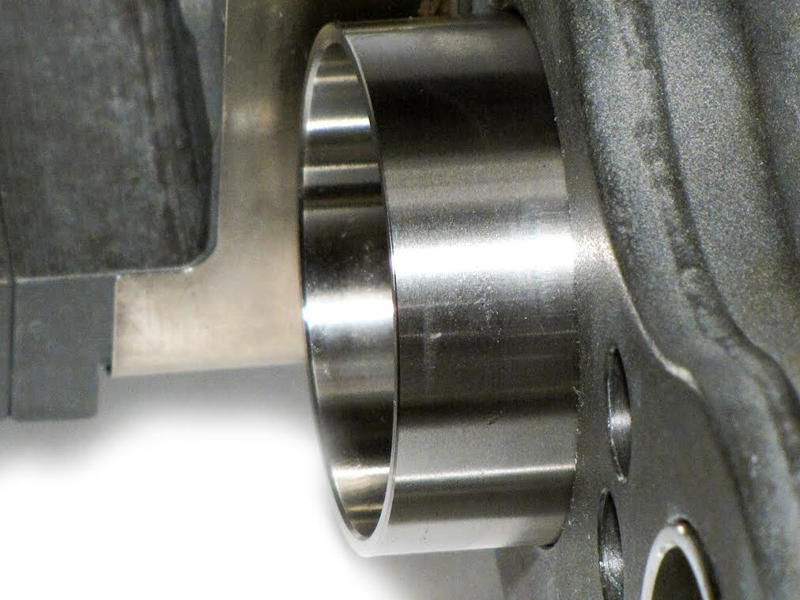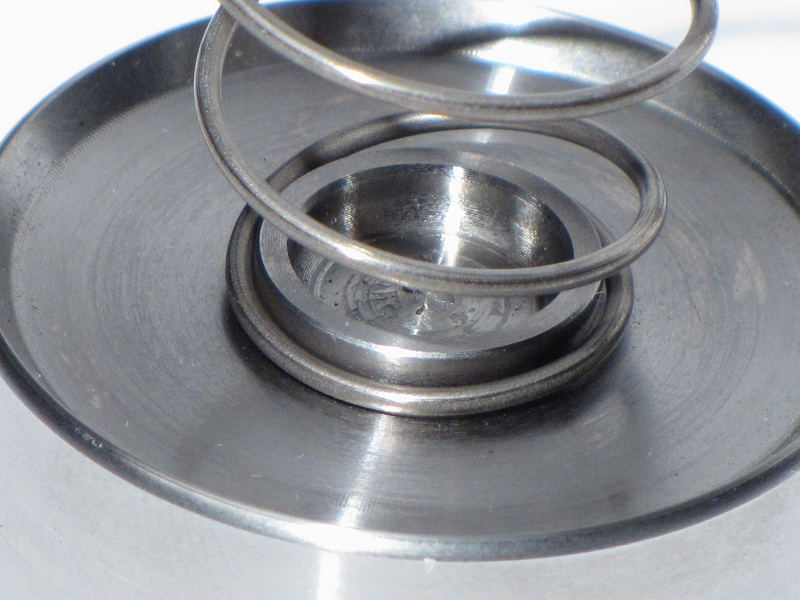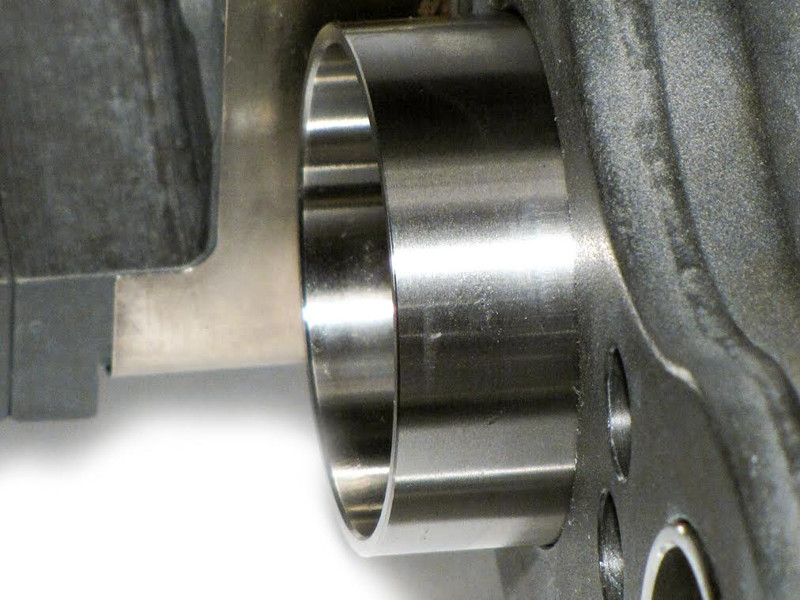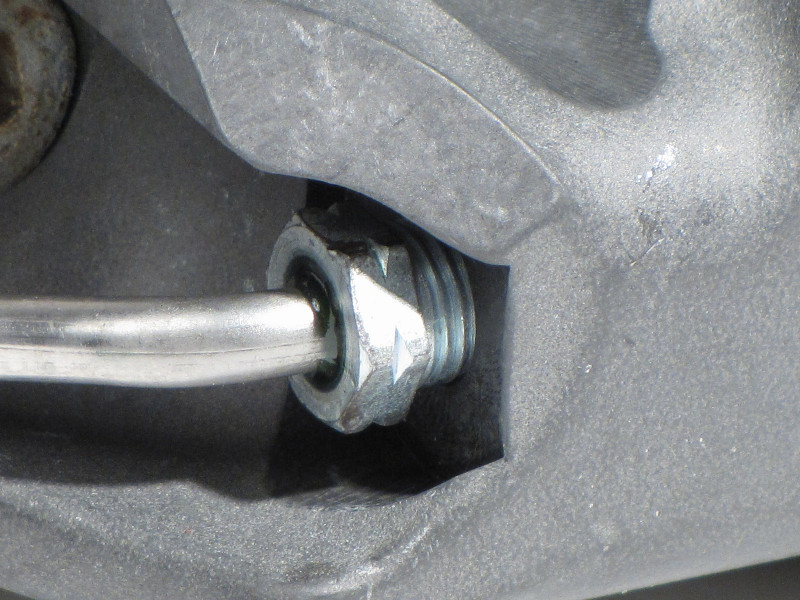- New Products
- Brake Caliper Stud Kits
- AP Racing Big Brake Kits
- AP Racing Brake Discs
- AP Racing Brake Calipers
- AP Racing Master Cylinders
- Essex Brake Bundles (upgraded pads, lines, fluid, discs that work with OEM Calipers)
- Brake Pads
- Brake Fluids
- Spiegler Brake Lines
- Tools, Temperature Indication and Protection Products
- Wheels
- Suspension
- Versodeck Flooring
- Apparel and Merchandise
- Formula SAE
- Clearance
CP8350-26S4L AP Racing Four Piston (Right Hand, Leading, Anodized)- 38.1/41.3mm
Part #: 13.05.20018
Brand: AP Racing
- Anodized aluminum 4-piston racing caliper
- Stainless Steel pistons with 4 lb. AKB springs & high temp seals
- Pistons=38.1mmx2, 41.3mmx2
- 4.8lbs. without pads
- Fits discs 280-330mm x 32mm
Show All vehicles this product fits
Application: Track

CP8350

Hard Anodized Finish
The first obvious weakness when looking at a typical aftermarket caliper is the finish. Most aftermarket calipers come in a painted finish, whether they are red, black, or gold. That painted finish is designed to look pretty and prevent corrosion in harsh winter environment. Unfortunately, for all of the compliments painted calipers generate, there is an associated price if you drive the car in a track environment. That price is the chipping, flaking, fading, color shift, and general degradation of that finish in a fairly short period of time. Some OEM calipers can go from the as-delivered color to a nasty shade of brown in as little as one weekend. While this is typically worn as a badge of honor among our more hardcore customers, let’s face it…they still look terrible. More importantly however, all of those bits of paint end up in places they’re not supposed to, which we’ll get to in a minute.
Why does this happen? Heat. Paint and powder coat cannot adequately handle track temperatures. Powder coat also has some notorious issues with shrinkage. The powder coat layer expands and grows when the caliper is heated. When it cools, the powder coat doesn’t necessarily shrink in step with the caliper body itself. What’s left is a loose shell of finish hanging limply on the caliper body. That shell then cracks and falls to pieces.
Paint can also have similar issues depending on how it is applied. If you were to line up a few aftermarket calipers from the same manufacturer, you would likely see that the painted finish on each of those calipers is slightly different. Some have a thicker coat, some thinner, slightly different shades of red, etc. Painting is to some extent an art form, and must be performed in a tightly controlled environment. If it isn’t, you’re always going to see variation. A thick coat makes the part look soft around the edges, and is prone to cracking off in the same manner as the powder coat described above, leaving the underlying finish exposed. A part without enough paint will look uneven, and will not protect the underlying aluminum particularly well either. In addition to problems with cracking, flaking, and uneven application, paint and powder coat also experience extreme color shift when heated. Red becomes maroon or black, gold becomes brown, and black just gets uglier.
The calipers we are using in the Essex Competition Kits are ultra-lightweight, stiff, and durable under all track conditions. The finish is a hard anodizing, which is the business under track conditions. When raw aluminum reacts with the oxygen in the air, a hard surface film develops on aluminum which prevents further degradation. The process is called oxidation, and you can think of it like rust. The anodizing process leverages this natural phenomenon, and takes it a step further to produce an extremely hard protective layer of aluminum oxide. It does so by running an electrical current through an acid bath, and dying it to the desired color. If you want to know more, Google it.
The result is a finish that is far more appropriate for racetrack use. Anodizing creates a uniform surface that is much more abrasion resistant than paint or powder coat. That means if you ding an anodized caliper with a box wrench when bleeding it, a big chunk of the finish isn’t going to chip off into your hand. While anodized calipers will still exhibit color shift, it will take a lot more heat to get them to change, and they won’t change as dramatically. More importantly though, you aren’t going to have bits of anodizing sticking to the sides of your pistons.
20mm Thick Brake Pads in A Commonly Available Shape
Race pads aren’t cheap, and you burn through them quickly if you spend any amount of time on track. The average set of race pads for the AP Racing CP8350 costs roughly $175. How many sets of brake pads do you go through in a season? Some people find that they could pay off their brake system in a short period of time on pad savings alone. Not only are the pads for the CP8350 inexpensive, they’re also 20mm thick. That extra thickness acts as a thermal barrier and helps keep heat out of your pistons and brake fluid. Finally, since this pad shape is used by a wide range of racing calipers, it’s available in just about every popular racing compound on the market. That means you’ll never end up in a pinch without pads. Cheap, thick, and available is a great combination for a consumable like race pads.
Below is a drawing of the basic pad shape used in the CP8350:

Dimensions= 133.2mm x 60.0mm x 20.0mm
The available pad compounds that Essex sells for the CP8350 caliper can be found below. Please keep in mind that there are many other compounds available on the market from other manufacturers. The list below represents only what Essex sells. Underneath the manufacturer list below, the pad compounds are listed from most aggressive to least aggressive.
Ferodo Racing
- DS3.12
- DSUNO
- DS3000
- DS1.11
- DS2500
Note on using brake pads different from those listed above
Again, please keep in mind that the above is not an exhaustive list, and that there are many other pad compounds available in this shape from other manufacturers. Please note however, that the pad shape we use in our caliper is available in a variety of radial depths (heights). When combined with the CP3908 325x32mm disc, Essex recommends the 50mm radial depth version. Other common radial depths in this pad shape are 43mm and 39mm. Those radial depths will fit into our caliper, but you will be leaving an unswept 'ring' around the disc near the attachment points to the hat (the pad will not hang as low in the caliper). Leaving a portion of the disc face unswept can create a temperature differential across the face of the disc, and doing so could lead to premature disc cracking. That said, we have not run into such a problem with our kits in the field.
Pad Cross Reference
Since
we do not sell most of the brands listed below, Essex cannot guarantee
the fitment of these pads in the AP Racing CP8350 caliper. Based on our research
however, we believe that these are the appropriate cross references for
the basic shape. However, you should verify with either the
manufacturer or your installer prior
to purchasing any of them.
| D43 Depth | D50 Depth | |
| Manufacturer | Part Number | Part Number |
| Carbotech | CTW7420 | CTFRP3116 |
| Circo | MB1680 | MB2660 |
| Endless | RCP106 | RCP156 |
| Ferodo | FRP3097 | FRP3116 |
| Hawk | HB521.800 | NA |
| Pagid | 2205USA | NA |
| PFC | 7751.xx.20 | NA |
| Project Mu | 999 | NA |
| Raybestos | R701 | NA |
| Wilwood | 7420 | NA |
Stainless Steel Pistons
There are people who will tell you that aluminum pistons are great for track calipers. They will tell you that the expansion rates of the pistons and caliper body need to be the same when heated. This argument is completely invalid and unproven. Those same people tend to get upset when you point out the fact that every serious race caliper, from every serious race caliper manufacturer on the planet uses either stainless steel or titanium pistons, period. There is a reason for this: they're better!
While most aftermarket calipers use a
pressed aluminum piston, the CP8350 uses an expensive machined
stainless steel piston. Aluminum has a much higher thermal conductivity
than stainless steel, and therefore transmits heat into your brake
fluid much more quickly. That is exactly what you don't want!
Stainless steel pistons are far superior
to aluminum pistons in creating a thermal barrier. They help keep heat
out of your brake fluid, preventing a soft pedal (brake fluid fade) on
the track. This has been proven over and over again
at all levels of motorsport.
expensive. Stainless steel offers the greatest balance of heat
reduction, weight, and price. They also alleviate the need for crutch
solutions such as fitting a titanium shim between the brake pad and
highly conductive aluminum pistons


Anti-knockback Springs
Not only are the domed back pistons ventilated stainless steel, they are also fitted with anti-knockback springs. Springs behind the pistons you ask? Yes, springs. If you’ve ever gone through a series of S turns and then had your pedal drop when going into the following brake zone, you have experienced knockback. To say it is disconcerting is an understatement. You’ll often see pro drivers ‘pre-tap’ their brakes lightly when approaching a brake zone. They are fighting knockback.
Knockback is a phenomenon that is common with fixed calipers. Knockback occurs when your car’s wheel, hub, and bearings deflect during cornering, allowing your brake disc to move out of sync with your caliper and brake pads. The caliper is less prone to movement because it is attached to the more rigid upright. As the brake disc deflects, it actually pushes the pads away from each other, forcing the caliper pistons back into their bores. The piston seals don’t have enough tension in them to return the pistons to their original location. That means there is slack in the system that needs to be taken up. When you press the brake pedal, it will continue to drop until that slack is taken up.
Anti-knockback springs help alleviate this situation by putting some tension on the back side of the pistons. When the disc deflects and makes contact with the pistons, the springs push the pistons back into their proper location, reducing slack in the system. That means less pedal drop and far fewer pucker-factor moments when going into heavy brake zones.
There are no major downsides to lightweight AKB spring as long as the caliper is designed to accommodate them. More specifically, AKB springs do not create any increased drag or wear on the pads and discs as long as the shape and material of the piston seals takes them into account.
As you're driving the suspension is constantly compressing, the disc is moving around laterally, and the pads are being pushed slightly away from the disc. Think of the seals in the caliper as a spring or hinge attached to the side of the piston, rather than just a ring through which the piston slides. In an AP Racing competition caliper, the groove in which the seal resides isn't a square cut groove.It has angles. When the pistons slide in or out there is friction between the outer piston wall and the seal, and the seal distorts a bit as shown in the illustration below.
A caliper piston sliding out to the left would distort the seal inthis manner (the slashes are the seals on either side of the piston):
/
---
---
\
As the piston slides back in to the right, the seal does this:
\
---
---
/
There is a certain amount of tension or friction that needs to be
overcome before the piston actually starts moving through the seal ring.
That tension/friction keeps the piston from dragging on the disc once
the pistons are pushed back into the bores by the disc/suspension
movement.
When AKB springs are added, a little more force is
required to push the pistons back into their bores than would be
required without them. After the spring is compressed, it unloads and
pushes the piston back to 'neutral.'
With the proper seal and
spring the goal is to keep the piston in the 'neutral' position, not
pressed against the disc. The piston is still able to slide freely in
either direction, but a bit of friction or tension needs to be overcome
initially to get it moving in either direction. The seal offers that
first bit of friction to limit movement, and then the spring provides
additional resistance. The end result is that the properly designed AP
Racing calipers won't drag or create additional or unnecessary wear,
despite having springs behind the pistons.


High Temperature, Low Drag Seals Without Dust Boots
We are often asked by potential customers if the calipers in our kits require frequent maintenance and rebuilding because the pistons don't have dust boots. We are perpetually shocked by this question because it makes no intuitive sense. If you have a product that is specifically designed to handle the extraordinary high-heat conditions of track use, why would it require more maintenance when used under those conditions vs. brake components that were designed to cruise around on the streets at low speed and temperature?
Many people confuse piston seals with dust boots. All calipers have seals. They're the little rubbery rings inside the piston bores (see pic below). If a caliper didn't have a seal, your brake fluid would leak out around the pistons! OEM caliper seals aren’t designed to handle constant trips to several hundred degrees without becoming brittle and leaking. Our calipers use special high-temp seals designed for track use. They are the exact same high temperature seals used in NASCAR Sprint Cup, ALMS, DTM, etc. That means they are less likely to get brittle and wear out when used under high-heat track conditions, and they require far LESS frequent replacement and servicing.
Most aftermarket calipers are designed for year round road use, and as such come with a bellows style external dust boot like the ones shown below. The rubber boot stretches as the piston extends, and its objective is to keep contaminants out of the piston bore. It's a nice concept, but we've seen customers burn those up in a single 20 minute track session! Once that happens, you're simply driving around with some tattered, burnt rubber bits attached to your pistons. At that point they're providing zero benefits to you. If you're going to instantly destroy them when you go to the track, why worry about having them in the first place? We skip making that mess for you by eliminating them from our design.
AP Racing High-Temp Piston Seal
OEM Dust Boot Before Track Use


Simple Pad Change with One Bolt
After the countless times you’ve changed your brake pads, you’re probably never too excited when it comes time to do so. Changing pads will no longer be a chore. No more fiddling with a hammer, punch, or pliers. AP’s bridge bolts pop out easily with a 5mm hex wrench and a 7mm socket. It will take you longer to pull off the wheel than it will to change pads. Less time futzing around in the paddock, and more time driving= fun.

Pistons Sized Specifically for Your Car
The piston sizes in our systems are specifically chosen to closely mimic the OEM brake torque on a given axle. As such, our front systems can be bolted to otherwise stock cars with no ill-effects, negative impact on ABS, etc. The vehicles stock master cylinder can remain, as can the OEM rear brake system.
Integrated Bleed Screw and Crossover Tube Protection
How often do you take the wheels on and off of your track car? At least once per event? A 30lb. wheel and tire combo can do quite a bit of damage when it collides with a caliper's bleed screw or crossover tube. Of the hydraulic components shown below, which do you think have better impact protection?
The CP8350's body was designed to protect the bleed screws and crossover
piping from heavy-handed crew members and track debris. These delicate
hydraulic components reside in small coves on the caliper body that can
withstand the impact of a wheel, tool, rock, etc. Wheel, pad, and
fluid changes become less worrisome and faster, and less time in the
pits equals more time on the track.


Ultra-lightweight, Compact Design
The Essex mantra when designing brake kits has always been, "Anything larger than necessary to get the job done is simply dead weight to drag around," and the CP8350 aligns perfectly with those values. One of the major problems with many of the brake packages currently on the market is wheel fitment. You’re offered gigantic discs and 12 piston calipers, with a pat on the back and a, “Good luck finding wheels to clear those things (insert sinister chuckle here).” The reality is that many casual racers want to use their OEM wheels on the track, or the smallest, lightest wheel they can find. Not only is saving unsprung weight critical, R compound tires are much more plentiful and cheaper for smaller wheels. If the components are designed properly with heavy use in mind, you don’t need to cram boat anchors under your wheels. If you’re worried about the loss of stiffness due to mass reduction, don’t. Some manufacturers use a heavier six piston caliper, but that's because the caliper wasn't designed or optimized for racing. In those cases, the same caliper may have been designed for use on much heavier road cars, and even trucks! AP Racing’s CP8350 calipers are incredibly stiff, and designed from scratch with only the racetrack in mind.
Lifetime Professional Reconditioning Service


Essex is AP Racing's official North American caliper reconditioning center. We have skilled service technicians rebuilding hundreds of AP Racing calipers each year for the top teams in NASCAR Sprint Cup, ALMS, etc. As an Essex customer, our rebuild service will always be available to you when your calipers need servicing. You simply remove your calipers from the car, drain/clean them, and ship them back to Essex. We take it from there:
Hardness testing: After disassembly your calipers will be Rockwell hardness tested against the standard for that particular caliper type as sold new. This test provides a relative understanding of how much fatigue and stiffness loss your calipers have experienced. Tired calipers lead to pad tapering, increased pad wear, leaky seals, and a loss of pedal firmness, all things you want to avoid. Essex will make a replace or rebuild recommendation based on the results of this test.
Ultrasonic cleaning: After passing the hardness test, your calipers will be placed in an ultrasonic cleaner to remove all dirt, debris, brake fluid, etc. This method produces results that are far superior to what the average racer could accomplish via hand-cleaning.
Inspection and re-assembly: All serviceable parts of the caliper will be inspected and replaced if necessary, including the seals, abutment plates, pistons, and bleed screws.
Cyclical Pressure Testing: After your calipers have been rebuilt, they will be cycled at high and low pressure on a pressure bench to ensure proper functioning. This is important, as certain leaks only show up under specific pressure conditions.
Price: The labor price to rebuild is roughly $80 per caliper. That does not include parts. Assuming there has been no damage to the caliper, Essex typically recommends replacing the seals ($60) and bleed screws ($15) during the standard reconditioning process. For roughly $160, you can have a fresh, professionally serviced caliper in peak operating condition. You won't get messy, and you'll know the rebuild was done by the same folks trusted by elite-level race teams.
| Caliper | CP8350-26S4L/27S4L |
| Weight no Pads | 4.8lbs. |
| Piston Sizes | 38.1mm x 2 |
| 41.3mm x 2 | |
| Piston Area | 49.56cm^2 |
| Inlet Thread | M10x1.0 |
| Mounting Type | Radial |
| Mtg. Centers | 152mm |
| Mtg. Offset | 44mm |
| Pad thickness | 20mm |
| Disc Diameter - mm | - Max = 330.0 |
| Disc Thickness - mm | - Max = 32.0 |
Brake Pads
The Brake Pads compatible with the AP Racing CP8350 caliper:
The available pad compounds that Essex sells for the CP8350 caliper can be found below. Please keep in mind that there are many other compounds available on the market from other manufacturers. The list below represents only what Essex sells. Underneath the manufacturer list below, the pad compounds are listed from most aggressive to least aggressive.
Ferodo Racing
- DS3.12
- DSUNO
- DS3000
- DS1.11
- DS2500
Note on using brake pads different from those listed above
Again, please keep in mind that the above is not an exhaustive list, and that there are many other pad compounds available in this shape from other manufacturers. Please note however, that the pad shape we use in our caliper is available in a variety of radial depths (heights). When combined with the CP3908 325x32mm disc, Essex recommends the 50mm radial depth version. Other common radial depths in this pad shape are 43mm and 39mm. Those radial depths will fit into our caliper, but you will be leaving an unswept 'ring' around the disc near the attachment points to the hat (the pad will not hang as low in the caliper). Leaving a portion of the disc face unswept can create a temperature differential across the face of the disc, and doing so could lead to premature disc cracking. That said, we have not run into such a problem with our kits in the field.
Pad Cross Reference
Since
we do not sell most of the brands listed below, Essex cannot guarantee
the fitment of these pads in the AP Racing CP8350 caliper. Based on our research
however, we believe that these are the appropriate cross references for
the basic shape. However, you should verify with either the
manufacturer or your installer prior
to purchasing any of them.
| D43 Depth | D50 Depth | |
| Manufacturer | Part Number | Part Number |
| Carbotech | CTW7420 | CTFRP3116 |
| Circo | MB1680 | MB2660 |
| Endless | RCP106 | RCP156 |
| Ferodo | FRP3097 | FRP3116 |
| Hawk | HB521.800 | NA |
| Pagid | 2205USA | NA |
| PFC | 7751.xx.20 | NA |
| Project Mu | 999 | NA |
| Raybestos | R701 | NA |
| Wilwood | 7420 | NA |























